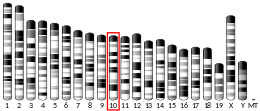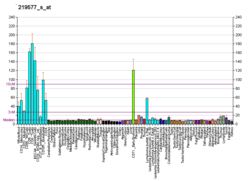ABCA7
ATP-binding cassette sub-family A member 7 is a protein that in humans is encoded by the ABCA7 gene.[5]
Function
The protein encoded by this gene is a member of the superfamily of ATP-binding cassette (ABC) transporters. ABC proteins transport various molecules across extra- and intra-cellular membranes. ABC genes are divided into seven distinct subfamilies: ABC1, MDR/TAP, CFTR/MRP, ALD (adrenoleukodystrophy), OABP, GCN20, and White. This protein is a member of the ABC1 subfamily. Members of the ABC1 subfamily comprise the only major ABC subfamily found exclusively in multicellular eukaryotes. This full transporter has been detected predominantly in myelo-lymphatic tissues with the highest expression in peripheral leukocytes, thymus, spleen, and bone marrow. The function of this protein is not yet known; however, the expression pattern suggests a role in lipid homeostasis in cells of the immune system. Alternative splicing of this gene results in two transcript variants.[5]
Clinical significance
Protein-disrupting variants in ABCA7 have been shown to predispose to Alzheimer's disease.[6] The Icelandic database of Decode Genetics has shown a doubled probability of developing Alzheimer's disease when inactive variants of the ABCA7 gene are present.[7]
See also
References
- GRCh38: Ensembl release 89: ENSG00000064687 - Ensembl, May 2017
- GRCm38: Ensembl release 89: ENSMUSG00000035722 - Ensembl, May 2017
- "Human PubMed Reference:". National Center for Biotechnology Information, U.S. National Library of Medicine.
- "Mouse PubMed Reference:". National Center for Biotechnology Information, U.S. National Library of Medicine.
- "Entrez Gene: ABCA7 ATP-binding cassette, sub-family A (ABC1), member 7".
- Chen JA, Wang Q, Davis-Turak J, et al. (April 2015). "A multiancestral genome-wide exome array study of Alzheimer disease, frontotemporal dementia, and progressive supranuclear palsy". JAMA Neurology. 72 (4): 414–22. doi:10.1001/jamaneurol.2014.4040. PMC 4397175. PMID 25706306.
- Steinberg S, Stefansson H, Jonsson T, Johannsdottir H, Ingason A, Helgason H, et al. (May 2015). "Loss-of-function variants in ABCA7 confer risk of Alzheimer's disease". Nature Genetics. 47 (5): 445–7. doi:10.1038/ng.3246. hdl:11250/296499. PMID 25807283. Lay summary – ScienceNews.
Further reading
- Kaminski WE, Orsó E, Diederich W, Klucken J, Drobnik W, Schmitz G (Jul 2000). "Identification of a novel human sterol-sensitive ATP-binding cassette transporter (ABCA7)". Biochemical and Biophysical Research Communications. 273 (2): 532–8. doi:10.1006/bbrc.2000.2954. PMID 10873640.
- Niwa M, Maruyama H, Fujimoto T, Dohi K, Maruyama IN (Oct 2000). "Affinity selection of cDNA libraries by lambda phage surface display". Gene. 256 (1–2): 229–36. doi:10.1016/S0378-1119(00)00348-6. PMID 11054552.
- Kaminski WE, Piehler A, Schmitz G (Nov 2000). "Genomic organization of the human cholesterol-responsive ABC transporter ABCA7: tandem linkage with the minor histocompatibility antigen HA-1 gene". Biochemical and Biophysical Research Communications. 278 (3): 782–9. doi:10.1006/bbrc.2000.3880. PMID 11095984.
- Tanaka AR, Ikeda Y, Abe-Dohmae S, Arakawa R, Sadanami K, Kidera A, Nakagawa S, Nagase T, Aoki R, Kioka N, Amachi T, Yokoyama S, Ueda K (May 2001). "Human ABCA1 contains a large amino-terminal extracellular domain homologous to an epitope of Sjögren's Syndrome". Biochemical and Biophysical Research Communications. 283 (5): 1019–25. doi:10.1006/bbrc.2001.4891. PMID 11355874.
- Broccardo C, Osorio J, Luciani MF, Schriml LM, Prades C, Shulenin S, Arnould I, Naudin L, Lafargue C, Rosier M, Jordan B, Mattei MG, Dean M, Denèfle P, Chimini G (2001). "Comparative analysis of the promoter structure and genomic organization of the human and mouse ABCA7 gene encoding a novel ABCA transporter". Cytogenetics and Cell Genetics. 92 (3–4): 264–70. doi:10.1159/000056914. PMID 11435699.
- Iida A, Saito S, Sekine A, Mishima C, Kitamura Y, Kondo K, Harigae S, Osawa S, Nakamura Y (2002). "Catalog of 605 single-nucleotide polymorphisms (SNPs) among 13 genes encoding human ATP-binding cassette transporters: ABCA4, ABCA7, ABCA8, ABCD1, ABCD3, ABCD4, ABCE1, ABCF1, ABCG1, ABCG2, ABCG4, ABCG5, and ABCG8". Journal of Human Genetics. 47 (6): 285–310. doi:10.1007/s100380200041. PMID 12111378.
- Wang N, Lan D, Gerbod-Giannone M, Linsel-Nitschke P, Jehle AW, Chen W, Martinez LO, Tall AR (Oct 2003). "ATP-binding cassette transporter A7 (ABCA7) binds apolipoprotein A-I and mediates cellular phospholipid but not cholesterol efflux". The Journal of Biological Chemistry. 278 (44): 42906–12. doi:10.1074/jbc.M307831200. PMID 12917409.
- Kielar D, Kaminski WE, Liebisch G, Piehler A, Wenzel JJ, Möhle C, Heimerl S, Langmann T, Friedrich SO, Böttcher A, Barlage S, Drobnik W, Schmitz G (Sep 2003). "Adenosine triphosphate binding cassette (ABC) transporters are expressed and regulated during terminal keratinocyte differentiation: a potential role for ABCA7 in epidermal lipid reorganization". The Journal of Investigative Dermatology. 121 (3): 465–74. doi:10.1046/j.1523-1747.2003.12404.x. PMID 12925201.
- Abe-Dohmae S, Ikeda Y, Matsuo M, Hayashi M, Okuhira K, Ueda K, Yokoyama S (Jan 2004). "Human ABCA7 supports apolipoprotein-mediated release of cellular cholesterol and phospholipid to generate high density lipoprotein". The Journal of Biological Chemistry. 279 (1): 604–11. doi:10.1074/jbc.M309888200. PMID 14570867.
- Ikeda Y, Abe-Dohmae S, Munehira Y, Aoki R, Kawamoto S, Furuya A, Shitara K, Amachi T, Kioka N, Matsuo M, Yokoyama S, Ueda K (Nov 2003). "Posttranscriptional regulation of human ABCA7 and its function for the apoA-I-dependent lipid release". Biochemical and Biophysical Research Communications. 311 (2): 313–8. doi:10.1016/j.bbrc.2003.10.002. PMID 14592415.
- Fu GK, Wang JT, Yang J, Au-Young J, Stuve LL (Jul 2004). "Circular rapid amplification of cDNA ends for high-throughput extension cloning of partial genes". Genomics. 84 (1): 205–10. doi:10.1016/j.ygeno.2004.01.011. PMID 15203218.
- Hayashi M, Abe-Dohmae S, Okazaki M, Ueda K, Yokoyama S (Aug 2005). "Heterogeneity of high density lipoprotein generated by ABCA1 and ABCA7". Journal of Lipid Research. 46 (8): 1703–11. doi:10.1194/jlr.M500092-JLR200. PMID 15930518.
- Jehle AW, Gardai SJ, Li S, Linsel-Nitschke P, Morimoto K, Janssen WJ, Vandivier RW, Wang N, Greenberg S, Dale BM, Qin C, Henson PM, Tall AR (Aug 2006). "ATP-binding cassette transporter A7 enhances phagocytosis of apoptotic cells and associated ERK signaling in macrophages". The Journal of Cell Biology. 174 (4): 547–56. doi:10.1083/jcb.200601030. PMC 2064260. PMID 16908670.
External links
- ABCA7+protein,+human at the US National Library of Medicine Medical Subject Headings (MeSH)
- ABCA7 human gene location in the UCSC Genome Browser.
- ABCA7 human gene details in the UCSC Genome Browser.
This article incorporates text from the United States National Library of Medicine, which is in the public domain.




